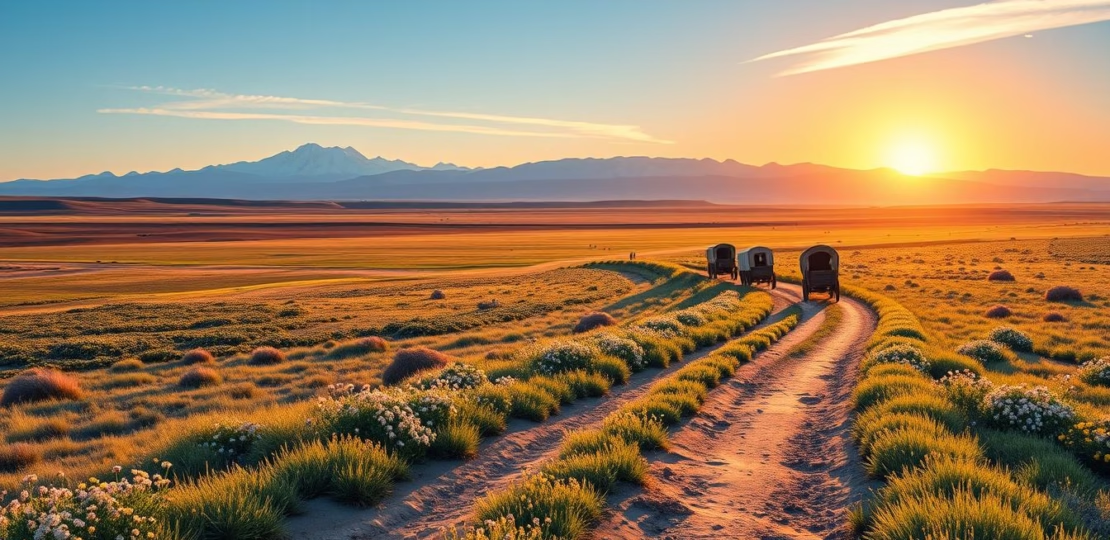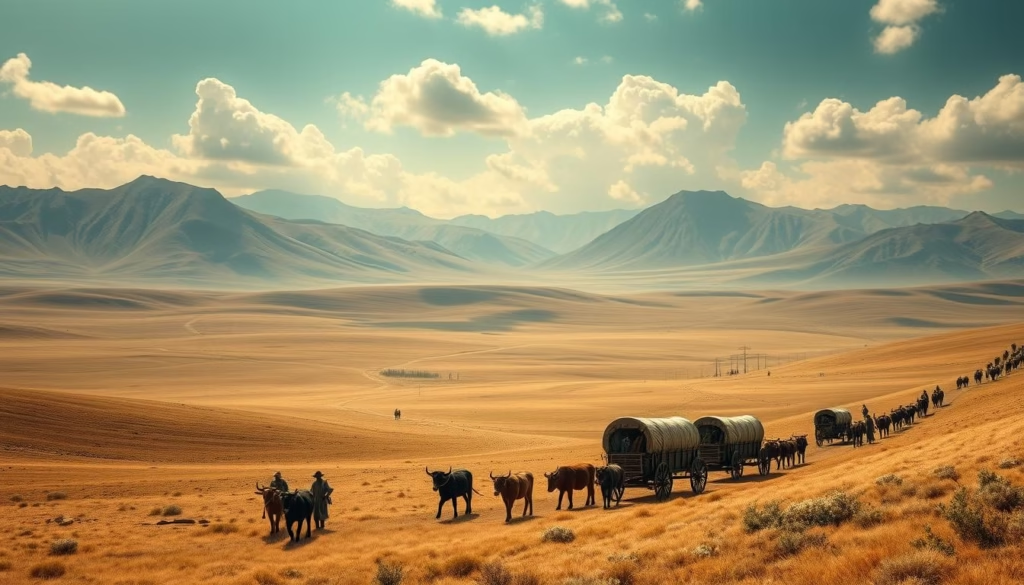Oregon Trail: The History and Significance of the Great Migration
January 10, 2025 | by m33559844@gmail.com

Ever thought about how the Oregon Trail changed America? It didn’t just connect the East to the West. It was a symbol of hope and challenge for many. Between 1840 and 1860, about 300,000 to 400,000 people traveled this path, seeking a fresh start1.
This trail was over 2,000 miles long. It was a journey of dreams and struggles. As we look into the Oregon Trail’s history, we’ll see how it shaped America’s growth and the stories of those who traveled it.
Key Takeaways
- The Oregon Trail facilitated the migration of 300,000 to 400,000 settlers seeking new opportunities.
- The journey typically took up to six months, with travelers covering 10 to 20 miles per day.
- The Great Emigration of 1843 included a wagon train with around 1,000 people and 120 wagons.
- Independence Rock served as a critical waypoint, marking a scheduling milestone for many travelers.
- Approximately 10% of emigrants did not survive the journey along the Oregon Trail.
If you’re ready to kickstart your travel journey with ease and exclusive savings, book your first trip now! Visit Trip.com using this special promotion link and register to reserve tickets, accommodation, and more. Don’t miss out on these incredible travel deals tailored for first-time travelers—start planning today!
The Beginnings of the Oregon Trail
The Oregon Trail started in the early 1800s with brave explorers. Lewis and Clark were among the first to light the way. Their journey inspired many to seek a new life in the west.
Early Expeditions and Exploration
Early explorers were key in creating the Oregon Trail. The trail was about 2,170 miles long, from Missouri to Oregon’s Willamette Valley. Over 40 years, about 650,000 people traveled the Overland Trails, including the Oregon Trail, by the end of the Civil War2.
The trip got shorter, from 160 days in 1849 to 140 days by 18592.
The Role of Fur Traders and Missionaries
Fur traders were important in the Oregon Trail’s early days. They built relationships with Native Americans and helped future settlers. Missionaries, like the Whitmans, also played a big role. They spread Christianity and documented their journeys.
People like Marcus and Narcissa Whitman helped make the trail popular. They encouraged families to take on the journey.
As more people traveled the trail, they faced many challenges. Some waited for weeks at camps to get ready. Cholera outbreaks in Independence made things even harder, leading to overcrowding3.
Despite these obstacles, the pioneers’ stories live on. Their bravery and determination are remembered to this day.
The Great Migration of the 1840s
The Great Migration of the 1840s was a key moment in American history. It saw a big wave of settlers moving west. The Great Emigration of 1843 was a major event, bringing thousands to Oregon for new chances.
This journey was more than just looking for land. It was about escaping economic troubles and seeking a better life.
Overview of the Great Emigration of 1843
In May 1843, hundreds gathered in Independence, Missouri. They were ready to travel 2,000 miles to Oregon4. Around 1,000 men, women, and children went with over 120 wagons and 1,000 animals54.
This large group showed how many were interested in Oregon’s fertile lands.
Factors Leading to Increased Migration
Many moved due to economic troubles and stories of Oregon’s riches. In the Midwest, families faced crop failures and money problems5. Missionaries and traders told exciting stories about Oregon, drawing more to the Oregon Trail.
By fall 1843, about 700 people made it to Oregon4. They faced many dangers but kept going for a better future.
Oregon Trail Overview
The Oregon Trail was a key path for settlers heading to the Northwest. It covered about 2,170 miles, starting in Missouri and ending in Oregon6. From the 1840s to the 1860s, it was used by around 400,000 people, including farmers and miners6.
Today, highways like Interstate 80 and Interstate 84 follow parts of this historic route. This shows the trail’s lasting impact on American travel6.
Route and Geography of the Trail
The Oregon Trail went through many landscapes, from Kansas prairies to Wyoming’s Rocky Mountains. It included big challenges like the South Pass, a 20-mile gap in the Continental Divide7. This terrain made the journey faster than other routes, like sailing around South America7.
Major Destinations Along the Trail
Important stops along the Oregon Trail included trading posts and landmarks. Fort Kearny and Fort Laramie were key places for rest and supplies6. Independence Rock was a milestone, where many pioneers celebrated their journey’s midpoint on July 47.
Fort Astoria, founded in 1812, was the first American settlement on the Pacific coast. It marked the trail’s end goal7.
Pioneer Life on the Oregon Trail
Pioneer life on the Oregon Trail showed human strength and unity in tough times. People faced many challenges, like managing supplies and dealing with changing weather. About 500,000 people traveled the Oregon Trail and others like it, leading to many interactions8. Diseases like cholera and smallpox were big health risks for families on their journey9.
Daily Life and Challenges Faced
Life started early, with a 4:00 am wake-up call. Men took care of the wagon and animals, while women cooked and looked after kids. They traveled about 15 miles a day, sometimes more on good days9.
But, illnesses, hunger, and accidents were common. These issues led to nearly 10% of travelers not making it9. Despite these hardships, pioneers found joy in homemade games, which helped them stay strong and united9.
Living Conditions and Travel Logistics
Living conditions varied a lot. Families rode in wagons for about 2,000 miles. By the 1850s, many rivers had ferries, making crossings easier but more expensive9.
Food was a big worry; many died from hunger. Bad weather, like storms and tornadoes, also posed dangers. Yet, the bonds within wagon trains were key. Families supported each other through the tough journey8.

If you’re ready to kickstart your travel journey with ease and exclusive savings, book your first trip now! Visit Trip.com using this special promotion link and register to reserve tickets, accommodation, and more. Don’t miss out on these incredible travel deals tailored for first-time travelers—start planning today!
Oregon Trail Landmarks and Notable Sites
Pioneers on the Oregon Trail found many important landmarks. These landmarks helped guide them and symbolized their tough journey. Independence Rock and Fort Kearny, a key military outpost, were essential for travelers.
Independence Rock: A Historical Marker
Independence Rock stands tall at 128 feet and is over a quarter mile long. It’s famous for the thousands of names carved into it by early travelers. Known as the “Great Register of the Desert,” it was a rest stop and a morale booster for those heading west.
This geological wonder marked a key point in their journey. It was about 2,000 miles from Independence, Missouri, to Oregon10. The rock’s height and accessibility made it a must-see for the 500,000 emigrants who traveled this route in the 19th century10.
Fort Kearny and Fort Laramie as Key Stops
Fort Kearny was one of the first military outposts on the trail. It provided vital supplies and safety to travelers. Fort Laramie was also a key stop, but it came with a high cost.
Prices skyrocketed; tobacco that cost $0.05 in St. Louis was $1.00 at Fort Laramie1110. This showed the challenges faced by emigrants. They relied on these stops for rest and supplies as they traveled through vast terrains10.
Dangers and Challenges Along the Journey
The Oregon Trail was filled with dangers that affected many pioneers. They faced health risks and environmental hazards. About 350,000 people traveled in the 19th century, but 30,000 didn’t make it, which is nearly 8.6%12. The trail was so dangerous that 10-15 people died for every mile traveled12.
Health Risks and Diseases
Diseases were a huge threat, causing 90% of deaths for those who got sick12. Cholera was the main killer, with some groups losing up to two-thirds of their members12. Diphtheria and dysentery also played a big role in the high death rates13. Pregnant women faced extra risks, as childbirth was common and often dangerous due to poor health and care.
Accidents and Environmental Hazards
The Oregon Trail was also full of environmental dangers. River crossings were deadly, with 37 people drowning at the Green River in one year12. Wagon accidents were another major cause of death, with children often being crushed12. Weather like hail and lightning also caused problems, leading to deaths and injuries12. The cold and snow in the mountains were deadly, as people rushed to cross before the snow came13.

| Hazard Type | Statistics |
|---|---|
| Disease Mortality | 90% of deaths among those who contracted diseases |
| Cholera-related Deaths | Up to two-thirds of wagon train members during severe outbreaks |
| Wagon Accident Fatalities | Most common cause of injury and death |
| Drownings | 37 individuals drowned at Green River |
| Severe Weather Effects | Frostbite and exposure accounted for significant mortality |
| Childbirth Incidents | High maternal and infant mortality rates |
The dangers on the Oregon Trail left a lasting impact on pioneers. They faced many challenges while seeking a better life.
The Legacy of the Oregon Trail
The Oregon Trail has made a lasting impact on American history and culture. It helped nearly 500,000 settlers move from Missouri to Oregon between the 1840s and 1860s. This journey is a key part of the westward expansion story14.
The trail’s influence can be seen in art, literature, and our collective memory. The challenges faced, like disease and accidents, showed the harsh realities of this journey. About one in ten settlers did not make it to their destination15.
Impact on American History and Culture
The Oregon Trail’s impact is clear in American identity. Stories of hardship, survival, and adventure have shaped our culture. These tales are celebrated in literature and film.
Events like the 1850 cholera outbreak had a big impact. This disease caused many deaths, affecting families and livestock15. These stories show the resilience and determination of the time.
Memorials and Historic Sites Today
Today, memorials honor the pioneers who traveled the Oregon Trail. Sites like the Oregon National Historic Trail help preserve history. They teach future generations about the sacrifices made during the journey west.
The Oregon Donation Land Act was important for land ownership. It allowed eligible white male citizens to claim land, but also showed discriminatory practices14. Preserving these memorials helps us remember the struggles faced, including the impact on Native American communities.
| Year | Event | Impact on Pioneers |
|---|---|---|
| 1850 | Cholera Outbreak | High mortality rates; many families devastated |
| 1855 | End of Oregon Donation Land Act | 2.5 million acres claimed, but discriminatory practices revealed |
| 1843 | First Large Migration | Set the course for future migrations; landmark event in westward expansion |
The Oregon Trail’s legacy continues to be felt in American history. Memorials honor the sacrifices of those who traveled. Exploring these sites helps us understand the complex stories of the West’s settlement14.
The Role of the Oregon Trail in Manifest Destiny
The Oregon Trail was more than just a path for pioneers. It was a key part of the story of Manifest Destiny. This idea drove Americans to expand across the continent, affecting Native American tribes greatly.
Historical Context of Westward Expansion
The Oregon Territory, claimed by the U.S., covered parts of Oregon, Washington, and British Columbia16. In the early 1800s, the U.S. and Spain fought over it, and the U.S. also challenged Russia’s control16. The slogan “54 degrees 40 minutes or fight” showed the strong feelings in 184316. By then, more Americans were moving to the area, leading to more debates16.
Connection to Native American Displacement
The Oregon Trail had a big impact on Native American tribes. Between 300,000 to 400,000 people used the trail from the mid-1800s to the late 1800s17. Travelers moved about 15 to 20 miles a day, finishing their journey in four to five months17. The large number of travelers at camps near forts showed the scale of the migration17. As settlers claimed land, Native communities lost their homes and culture, leading to ongoing discussions about land and heritage.

If you’re ready to kickstart your travel journey with ease and exclusive savings, book your first trip now! Visit Trip.com using this special promotion link and register to reserve tickets, accommodation, and more. Don’t miss out on these incredible travel deals tailored for first-time travelers—start planning today!
| Event | Date | Key Outcome |
|---|---|---|
| Transcontinental Treaty | 1819 | Spain ceded claims to Oregon Territory |
| Oregon Treaty Ratification | June 18, 1846 | Established U.S.-Canada border at the 49th parallel |
| Peak of Oregon Trail Usage | Mid-1840s to Late 1860s | 300,000 to 400,000 users of the Oregon Trail |
The Oregon Trail’s story of destiny and displacement is ongoing. It continues to influence how we view the trail’s impact on Native American communities1617.
Modern Interpretations of the Oregon Trail
The Oregon Trail has always fascinated people. Now, it’s even more popular through the Oregon Trail Game. This game has grown a lot, becoming a fun way to learn for many. It was released for Apple Arcade in April 2020, just when gaming was booming because of the pandemic. It attracted fans of all ages, showing it’s loved by both old and young18.
The Oregon Trail Game and its Cultural Significance
The Oregon Trail Game is a big deal for many. Gameloft worked with three Indigenous historians to fix old mistakes. They wanted to show Native American life more accurately18. They changed how Native characters were shown, making them more diverse18.
History shows Native American communities suffered a lot. Their land was taken unfairly, a sad part of our past19.
Interactive Maps and Virtual Tours Today
Now, you can explore the Oregon Trail online. There are interactive maps and virtual tours that bring the trail to life. These tools let you see what pioneers faced, making history come alive20.
These resources help us understand the trail’s history. They show the big challenges pioneers had to overcome19.
Conclusion
The Oregon Trail is a key part of American history. It shows the bravery and hard work of settlers who faced many challenges on their way to the west. This trail, over 2,000 miles long, went from Independence, Missouri, to Oregon City, Oregon. It was a symbol of the drive to explore and expand westward.
Between the 1830s and 1869, about 400,000 settlers made this journey. The first big wagon train started in 1843, with around 1,000 people2122.
The Oregon Trail’s importance goes beyond just numbers. It had big impacts on culture, society, and politics in the United States. Disease was a big problem, causing many deaths and showing the dangers of migration2223.
It took pioneers up to five months to travel the trail. They went up to 16 miles a day, looking for a better life. Before starting, they often sold their belongings21.
Going-to-the-Sun Road: The Best Hiking Trails Along the Way . Looking back at the Oregon Trail’s history, we see its lasting impact. The trail helped settle the west and shaped American identity. It teaches us valuable lessons from those who made this huge journey212223.
FAQ
What was the Oregon Trail?
The Oregon Trail was a historic route. It helped thousands of settlers move from the Midwest to Oregon. This journey happened from the early 1840s to the late 1860s, covering over 2,000 miles.
Why was the Oregon Trail significant in American history?
The Oregon Trail was a huge migration in American history. It shows the spirit of Manifest Destiny. It changed culture, demographics, and became a symbol of westward expansion.
What were some key landmarks along the Oregon Trail?
Key landmarks included Independence Rock, known as the “Great Register of the Desert.” Military outposts like Fort Kearny and Fort Laramie also played a big role. They provided resources and safety to travelers.
What challenges did pioneers face on the Oregon Trail?
Pioneers faced many challenges. These included diseases, harsh weather, fatigue, and accidents. Nearly one in ten travelers did not make it to their destination.
How did the Oregon Trail influence Native American communities?
The Oregon Trail’s westward expansion displaced Native American tribes. This led to cultural changes and conflicts over territory.
What modern representations of the Oregon Trail exist today?
Today, there’s the Oregon Trail Game, which teaches about pioneer life. There are also interactive maps and virtual tours that recreate the journey.
How does the Oregon Trail relate to Manifest Destiny?
The Oregon Trail shows the idea of Manifest Destiny. It shows the belief that American settlers were destined to expand across the continent. This had a big impact on culture and history.
What resources are available for those interested in the Oregon Trail?
There are many resources. These include the Oregon National Historic Trail, interactive maps, and educational materials. They offer insights into the history, landmarks, and events of the Oregon Trail.
Can you explain the role of missionaries on the Oregon Trail?
Missionaries were key in promoting Oregon’s fertile lands. They encouraged migration by spreading the word about the opportunities for settlers.
What is an interactive map of the Oregon Trail?
An interactive map lets users explore the Oregon Trail route and landmarks. It shows historical sites in a fun way. It helps understand this important migration pathway.
RELATED POSTS
View all



